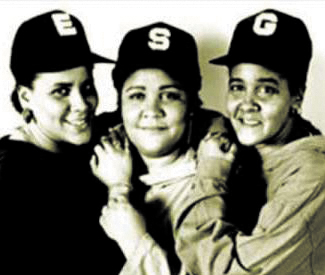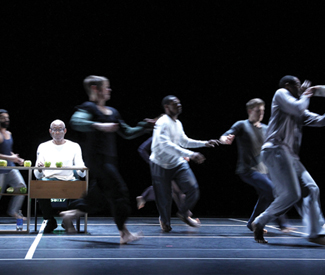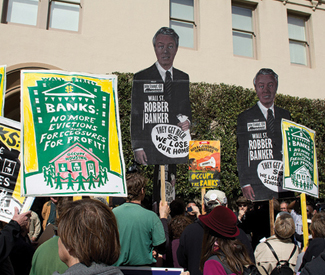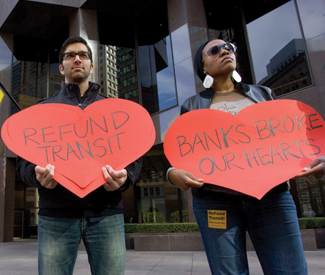marke@sfbg.com
This past year was pretty dang rad in the clubs (and here I must stop to thank my fantastic hairstylist, Paul at Zip Zap, for helping make it especially happen for me). Despite the recession — and the continued flight of us decadent types — the parties never stopped. In fact, they seem to have gotten even more varied and creative, with a sophisticated energy that’s welcoming and ecstatic, flinging their doors open wide for hot-footed like minds. I was inspired during a particularly riotous drag show featuring flaming dildos, pancake batter, and Shabba Ranks to put together this list of regular happenings I’m into, a kind of snapshot of our fine nightlife, and a guide to more good times, if you feel me.
That 62 recommendations for weekly and monthly parties sprang to mind immediately — bluegrass, rocksteady, gay goth, electro-cumbia, zouk, hypercrunk, Brit pop, etc — shows out the sheer vibrance of the local scene. The parties listed below are ones I wholeheartedly recommend: friendly, affordable, no dress codes or booth reservations, full of adventurous music and folks who aren’t afraid to move a little sideways when they dance, rather than just nod their heads or pump their fists (and who actually have fun, rather than act like they’re having fun in a video). Also: a good chance of getting laid.
There’s oodles more shindigs I itched to list — some are too new for me to get a proper handle on yet, others I’ve only popped in on, and I’m sure a few I forgot (I’m perma-stoned.). Also, I didn’t throw down in the East Bay as much as I’d have liked; send me your hot tips for next time.
So this list will grow and be updated — bookmark it for later use. And follow our music listings and my weekly Super Ego column for special nightlife events.
All events below are 21+ and end at 2 a.m. (except where noted). Enough blather, Barbra! Tonight, we dance.
MONDAYS
TUESDAYS
WEDNESDAYS
THURSDAYS
FRIDAYS
SATURDAYS
SUNDAYS
ROVING PARTIES
Bluegrass Mondays Live bands, well-picked tunes, and a hootenanny crowd help get the new week twang on right — strumming legend Toshio Hirano appears monthly to show how it’s really done. 9 p.m., free. Amnesia, 853 Valencia, SF. www.amnesiathebar.com
Death Guild Our fair burg’s weekly 18+ goth classic, bursting with kohl-rimmed, cyber-punk joy, now going on 19 years of dark celebration. DJs Decay, Melting Girl, and more deliver chills from Cocteau Twins wormholes to bleeding edge nu-IDM. 9:30 p.m.-afterhours. $3 before 10 p.m., $5 after, 18+. DNA Lounge, 375 11th St., SF www.deathguild.com
Motown on Mondays The SF scene’s Monday go-to for some soulful comfort food, with a swinging crowd and some mighty fine Motown and more selections from DJ Gordo and guests. 6 p.m., free. Madrone, 500 Divisadero, SF. www.madronesf.com
Skylarking High-flying hazy fantasia of roots reggae and dub goodness from a host of local reggae royalty with a more-than-welcoming vibe. 10 p.m., free. 3089 16th St., SF. www.skylarkbar.com
Wanted A very sexy mixed party in the Castro for indie dance and electro rock-oriented folks who aren’t quite ready to end the weekend. Gives a downtown NYC vibe with SF (lack of) attitude. With DJs Key&Kite and Richie Panic. 9 p.m., free. QBar, 456 Castro, SF. www.sfwanted.com
Viennetta Discotheque What other intimate, kooky-lovely queer party would celebrate its recent anniversary with 40 McDonald’s cheeseburgers and a platter of fries for hungover voguers to “serve?” From over-the-top disco to tomorrow’s dub-techno to just WTF, DJs Stanley Frank and Robert Jeffrey whip it up. 10 p.m., free. UndergroundSF, 424 Haight, SF. 133 Turk, SF.
Bass Cellar An uncomplicated blast of dubstep (tending toward the brostep variety) with a crowd that mixes the mainstream with the more devoted, and never fails to deliver on the wob-wobs. 10 p.m., free. The Cellar, 685 Sutter, SF. www.thecellarsf.com
Bless Up Premier reggae, riddim, and dancehall crew Jah Warrior Shelter Hi Fi keep the Upper Haight rocksteady with live guests, smokin’ tunes, and a forest of cute dreds. This is the good stuff. 10 p.m., $5. 1840 Haight, SF. www.milksf.com
High Fantasy Apocalyptically glamorous queer rabble-rousers Alexis Bair Penney and Myles Cooper make gutter dreams come true in the Tenderloin, with artistically challenging drag performances, international surprise guests, and polymorphous perversity on tap-tap-tap. 10 p.m., $2. Aunt Charlie’s Lounge, 133 Turk, SF. www.auntcharlieslounge.com
Booty Call Ever-gorgeous queen Juanita More and ever-energetic promoter Joshua J host this weekly queer night bursting with forward looks and youthful cuteness. The stated draw is the fun photobooth in back, tricked out by noted artists, but the free-spirited, non-pop house tunes are tasty, too. 9 p.m., $3. QBar, 456 Castro, SF. www.botycallwednesdays.com
Housepitality Good ol’ back-to-basics, world class house dancing with a warm, family vibe and some refreshing sophistication without pretension — also, some mighty hot hoofers on the dancefloor and guests in the booth. Pretty much a perfect hump night out. 9 p.m., $5 before 11 p.m., $10 after. Icon, 1192Folsom, SF. www.housepitalitysf.com
Coo Yah DJs Green B and Daneekah up the steamy reggaeton and dancehall ante with some strong female power behind the decks, live Caribbean and UK guests, and a diverse crowd who know how to put one leg up with the jams. 9 p.m., free. SOM, 2925 16th St., SF. www.som-bar.com
Bondage a Go Go The teasing tension between what can legally go on at this polyamorous showcase (now approaching its 20th year) and what actually might go on is just one of the exquisite tortures/pleasures for its many fans. DJs Damon and Tomas Diablo keep the rock and retro atmosphere dark and hot. 9:30 p.m., $10. Cat Club, 1190 Folsom, SF. www.bondage-a-go-go.com
WEDNESDAY MONTHLIES
Shutter Goth glamour exquisitely laid over indie sensibilities: modern darkwave and ’80s synth strains form the backdrop for a monthly ball of debaucherous shivers and Romantic excess. Fourth Wednesdays, 10 p.m., $5. Elbo Room, 647 Valencia, SF. www.facebook.com/Shutter.SF
Stay Gold Adorably spazzy neon-sweatered, asymmetrically haircutted, often pantsless sexy young queer people unite! And get down to some pretty fierce reggaeton, hip-hop, and non-ironic pop jams from DJs Pink Lightning and Rapid Fire. Last Wednesday of the month, 10 p.m., $3 before 11 p.m., $5 after. Public Works, 161 Erie, SF. www.facebook.com/staygoldsf
Qoöl Mammoth One of our oldest funky techno crews, Qoöl, joins forces with beloved insane Burning Man camp Pink Mammoth for a monthly SF scene reunion — as a happy hour, which means we’re growing up? Oh dear. Last Wednesday of the month, 6 p.m.-11 p.m, free. The EndUp, 401 Sixth St., SF. www.qoolsf.com
Afrolicious All things awesomely funky, especially Latin and African, for a packed house, from adorable DJ brothers Pleasuremaker and Señor Oz. Live percussion and performances, international guests, and a free-spirited atmosphere keep it lively. 9:30 p.m., $5. Elbo Room, 647 Valencia, SF. www.elbo.com
Base Upscale club Vessel dips into the scrappy underground (a little) by hosting some of the most consequential names in international techno every week for an adoring, knowledgeable, dance-ready audience. 10 p.m., $10. Vessel, 85 Campton Pl., SF. www.vesselsf.com
Future Perfect This packed party pretty much realizes its admirable aim to demolish all genre boundaries and just play “cool, contemporary music no matter what.” That makes it hard to write about, but easy to dig, especially with yummy weekly live guests that have included Light Asylum, Cold Cave, and Dubbel Dutch. 10 p.m., $10–$15. Monarch, 101 Sixth St., SF. www.monarchsf.com
The Monster Show If San Francisco has a drag sweetheart, it must be the loveable Cookie Dough, who isn’t afraid to dump buckets of blood around the stage or skewer Toddlers and Tiaras or Whitney Houston for her gently twisted, often outrageous Monster Show performance night. DJ MC2 rocks the tunes. 10 p.m., $5. Midnight Sun, 4067 18th St., SF. www.cookievision.com
NightLife Hey smart peeps (and friends), the incredible Cal Academy of Sciences puts on one of the best parties in the city, with different intelligent but fun themes, exciting DJs, and informative talks each week. Yes, there are multiple bars and dancefloors. Yes, there are penguins. 6 p.m.-10 p.m., $12. California Academy of Sciences, 55 Music Concourse Dr., Golden Gate Park, SF. www.calacademy.org/nightlife
Popscene All the bright young indie pop fans converge on this long-running 18+ party to peep up-and-coming international live bands often so fresh the Internet has yet to discover them — plus some touching nods to the alternative pop styles of yore. 10 p.m., $10–$15, 18+. Rickshaw Stop, 155 Fell, SF. www.popscene-sf.com
Ritual Our best dubstep party, mixing anarchic raving with some damn smart programming and top notch selections. DJs Nebakaneza, Johnny5, and the Irie Cartel keep the sound an art form, exploring its outer, moodier reaches while still punching your solar plexus good. 10 p.m.-3 a.m., free before 10 p.m., $5 after. Temple, 540 Howard, SF. www.templesf.com
The Tubesteak Connection After almost eight years of reviving rare 1970s and ’80s gay bathhouse disco in an atmosphere that encourages sleazy cruising (and bans all things digital), DJ Bus Station John’s club is still a sensation — DJs make the pilgrimage, often on their knees, from around the globe to catch up on the sex music of the past. 10 p.m., $5. Aunt Charlie’s Lounge, 133 Turk, SF. www.auntcharlieslounge.com
THURSDAY MONTHLIES
Relax Relate Release Three of the craziest mofo DJs on the scene, Vin Sol, Richie Panic, and 5kinAndBone5 indulge their deeper eclectic (yet still plenty bumpin’) sides, with schweet selections spanning classic disco to hyphy gems, bass oddities to vogue jams. 10 p.m., $5. 222 Hyde, SF.
I Heart Cochina Tonga’s Take one plainish gay bar (LookOut), dress it up like the tackiest Mexican-wannabe cabana bar ever, add in a loco drag queen (Ambrosia Salad) and two DJs picantes (Stanley Frank and Taco Tuesday) who aren’t afraid to salsa-fy some party tunes — and shazam! A primo fiesta. Fourth Thursdays, 9 p.m., free. The LookOut, 3600 16th St., SF. www.lookoutsf.com
Blow Up Fantastically glamorous and classy-yet-raging 18+ underground electro, nu-disco, and post-French Touch night, hosted by Ava Berlin and Jeffrey Paradise, now seven years old and as fashionable as ever with a slew of talented DJs, weekly guests, relatable moments, and incredible looks. 10 p.m., $10–$20, 18+. DNA Lounge, 375 11th St., SF. www.blowupsf.com
Hot Boxxx Girls Legendary gender illusionists of the Tenderloin shower you with bewitching beauty and ravishing razzle-dazzle in this must-see drag show (also on Saturday nights). Once you witness these spirited gals take on your favorite showtune, pop hit, or power ballad, you’ll never hear it the same. Bring lots of singles for tipping. 9 p.m., $5. Aunt Charlie’s Lounge, 133 Turk, SF. www.auntcharlieslounge.com
Loose Joints Awesome rare grooves, from boogie raveups and old school hip-hop to Latin jazz and post-punk gems (plus some super-current cuts) that please vinyl mavens, sure, but also serve to keep the floor packed with hotties. DJs Tom Thump, Damon Bell, and Centipede combine their diverse crate-digging styles into a quality supersound. 10 p.m., $5. Make-Out Room, 3225 22nd St., SF. www.makeoutroom.com
Paris-Dakar Coupe Decale There’s pretty much something fab going down every night at Senegalese hotspot Little Baobab, but this party (also on Saturday) really turns the sweat on, with Central and West African rhythms — plus zouk, soca, Brazilian, reggae, and a bottom-dropping global stew of others. 10 p.m., $5. Little Baobab, 3388 19th St., SF. www.bissapbaobab.com
Some Thing Taking drag (and performance) into some incredible new and WTF zones — with lots of fun dancing afterward, and a fantastic craft table courtesy of Haute Gloo — the Some Thing trio of Glamamore, VivvyAnne ForeverMore, and DJ Down-E add some theatrical, dramatic, and loopy oomph to the SF weekend. 10 p.m.-afterhours, $7. The Stud, 399 9th St., SF. www.studsf.com
FRIDAY MONTHLIES
120 Minutes Based goth, rapegaze, hypercrunk — if you’re unfamiliar with these hysterically nihilistic, through-the-looking-glass genres, don’t worry: host Marco de la Vega and crew will slay you through it. First Fridays, 9 p.m., $10–$15. Elbo Room, 647 Valencia, SF. www.elbo.com
Braza! Seductive Brazilian-themed goodness — from live Forro bands to forward-thinking DJs from Rio — and a smokin’ crowd of regulars, full of warmth and positive energy. First Fridays, 10 p.m.-3 a.m., $10. SOM, 2925 16th St., SF. www.brazasf.com
Low End Theory The seminal LA future bass and heady glitch party has done spectacularly with its monthly outpost here, bursting with eclectic live acts and well-known woofer Picassos. First Fridays, 10 p.m.-4 a.m., $15–$20. 103 Harriet, www.1015.com
Oldies Night It’s all about the doo wop, baby. Underground ’50s and ’60s rock and soul get the no-pressure crowd fired up like Tracy Turnblad on a bender. First and Third Fridays, 9:30 p.m., $3. The Knockout, 3223 Mission, SF. www.theknockoutsf.com
Taboo Truly moving soulful house sounds in Oakland from the great David Harness and friends, in a family atmosphere with old school good Bay vibes. First and Third Fridays, 9 p.m.-3 a.m., free before 10 p.m., $5 before 11 p.m., $10 after. Bench and Bar, 510 17th St., Oakl. www.bench-and-bar.com
Baxtalo Drom Brassy Balkan folk and wild Romany (gypsy) whirls were recently ubiquitous in local nightlife — this “gypsy punk cabaret” was one of the original parties and still one of the best. Fourth Fridays, 9 p.m., $7–$10. Amnesia, 853 Valencia. www.amnesiathebar.com
Teenage Dance Craze Another ’50s and ’60s rock and soul night at the Knockout (which is chockful of old-timey neat things), but with a lot more twists — of the Chubby Checker variety. The crowd is crazed for it all, indeed. Fourth Fridays, 10 p.m., $10. The Knockout, 3223 Mission, SF. www.theknockoutsf.com
Bootie The grandpappy of mashup clubs, going on eight years of bastard pop and cheeky pirate-themed fun. The crowd may have broadened, but Bootie head DJs Adrian and Mysterious D still program mindfuck drag performances and leftfield happenings to keep merry dancers (and loud singers-a-long) on their toes. They can even turn a Katy Perry-themed night into something subversive. 9 p.m.-afterhours. $10 before 10 p.m., $15 after. DNA Lounge, 375 11th St., SF. www.bootiesf.com
El SuperRitmo! Your best weekly bet for “the finest African music of Latin America,” with a whole tropical world of other styles thrown into the mix by spunky resident DJs Roger Mas and Kool Kyle. The crowd can get a wee bit dressy (so polish your patent leather Keds), but the floor never quits. 10 p.m., $5. Make-Out Room, 3225 22nd St., SF. www.makeoutroom.com.
SATURDAY MONTHLIES
Haçeteria Acid house, early industrial, classic rave, warm Italo: A heartfelt tribute to Manchester and Chicago warehouse sounds of the ’80s and early ’90s with a few nifty musical spanners thrown into the works. First Saturdays, 9 p.m.-3 a.m., free before 10:30 p.m., $3 after. Deco Lounge, 510 Larkin, SF. www.facebook.com/rancheria
Hard French Amazing queer soul party that digs up vintage 45s from the ’50s on up and spins a patio full of jiggling personalities into a smiley lather. DJs Carnita and Brown Amy crank the ol’ Victrola. First Saturdays, 2 p.m.-8 p.m., $7. El Rio, 3158 Mission, SF. www.hardfrench.com
Kontrol For six years the top-notch Kontrol crew has brought some of the finest innovators in techno to play live sets all night at the EndUp. Don’t worry, the sometimes wonky intelligence and occasional tech crowd overload never overshadow the ecstatic dancing to be had. First Saturdays, 10 p.m.-6 a.m., $20, The EndUp, 401 Sixth St., SF. www.kontrolsf.com
Leisure 1990s Britpop and trip hop, plus mod ’60s scooter gems and bubble gum pop from DJs Omar and Aron Axelson make everything laidback, baby. First Saturdays, 10 p.m.-3 a.m., $5. Cat Club, 1150 Folsom, SF. www.sfcatclub.com
Debaser After four years of excellently reviving grunge and alternative rock for flannel-shirted, babydoll-dressed 1990s fanatics, DJs Jamie Jams and Emdee are incorporating hip-hop and taking on a huge project: dedicating a night to every year of that nutso decade, starting with 1989 on March 10. Second Saturdays, 10 p.m., free with flannel before 11 p.m., otherwise $5. The Knockout, 3223 Mission, SF. www.debaser90s.com
Love Will Fix It Those questing to slake their thirst for vinyl ’70s and ’80s funk and R&B classics (a surprisingly rare flavor on the scene these days) played in a Market Street hole-in-the-wall bursting with positivity and hot-hot gays and friends need look no further than DJ Bus Station John’s latest venture. Second Saturdays, 10 p.m., $5. The Hot Spot, 1414 Market, SF.
Non Stop Bhangra Welcoming and wild, this tribute to the contemporary Punjabi (via London) dance sound mixes in plenty of tasty bass variants and one of the most diverse crowds in the Bay. DJ Jimmy Love and the dholrhythms dancers host awesome, global-eared guests. Second Saturdays, 9 p.m.-3 a.m., $10–$15. Public Works, 161 Erie, SF. www.publicsf.com
Beatpig Intensely fun and charitable gay times at the Powerhouse bar in SoMa, as DJs Juanita More and Sidekick and host W. pack the leather-lovin’ hole with nightlife personalities, pleasant dancing, and often much sex cruising. Third Saturdays, 9 p.m., $5. Powerhouse, 1347 Folsom, SF. www.beatpigsf.com
Dial Up Electronic music bears, kooky gay club kids, and serious techno lovers unite with posses of like minds and sometimes wild outfits for neat guest DJs and surprise drag performances. With DJs Doc Sleep, Dabecy, and Robert Jeffrey, hosted by lovebirds Tim and Jorge. Third Saturdays, 10 p.m., $5. 222 Hyde, SF. www.facebook.com/dialupsf
New Wave City The original ’80s retro party, going on 20 years — it was retro almost before retro began! DJs Skip, Shindog, and Low-Life pump out the angular New Wave and darker singalong jams, with all the fun theme nights you could ask for. Third Saturdays, 9 p.m.-3 a.m., $7 before 10 p.m. $12 after. Cat Club, 1190 Folsom, SF. www.newwavecity.com
Tormenta Tropical Elecro-cumbia heaven, as a hip crowd gets down to the latest dance music of the Latin American diaspora. Absolutely filthy-lovely global grooves right here, from DJs Oro11 and Shawn Reynaldo. Second Saturdays, 10 p.m., $5 before 11 p.m., $10 after. Elbo Room, 647 Valencia, SF. www.elbo.com
Booty Bassment “Squat! Squat! Gobble! Gobble! Squat-squat! Gobble-gobble!” If shouting these words in your head makes you want to slip down your hot pants and show your silky thong for $$$, this hipstery-but-fine booty music paradise has your bottom number. Third Saturdays, 10 p.m., $5. The Knockout, 3223 Mission, SF. www.facebook.com/bootybassment
OK Hole Real risk-taking live electronic, synth, and leftfield analog music performances for enthusiastic spectators, with jaggedy dance tunes from resident DJs Nay Nay, C.L.A.W.S., and (Keep It) Keith Slogan. Third Saturdays, 9 p.m., $5. Amnesia, 853 Valencia, SF. www.amnesiathebar.com.
Icee Hot The city’s best showcase for razor’s edge developments in underground bass music and the UK sounds of now — with some classic house and techno stunner guests thrown in for mega-measure. A lifeline for those tired of hearing this good stuff via Internet. Fourth Saturdays, 10 p.m.-3 a.m., SF. $5 before 10:30, $10 after. Public Works, 161 Erie, SF. www.publicsf.com
Go Bang! DJ Steve Fabus has been spinning since the earliest days of San Fran-disco, and when teamed up with young fanatic DJ Sergio — it’s been fire. Each month brings an onslaught of disco heat, with repolished red-light classics and rare vinyl revivals stoking an eager, off-the-shoulder crowd. Fourth Saturdays, 9 p.m., $5. Deco Lounge, 510 Larkin, SF. www.gobangsf.com
Reggae Gold Don’t let the classy, sparkling crowd of gorgeously toned people throw you off — there’s plenty of friendliness here for all. Top dance hall and reggae, flavored with spicy soca and and hip-hop, yes please. Fourth Saturdays, 10 p.m.-4 a.m., $5–$10. Six, 66 Sixth St., SF. www.reggaegoldsf.com (Also second Saturdays at New Parish in Oakland).
Dark Room Campy gay goth glory, replete with shivery drag performances, industrial tunes, and plenty of upside-down crucifix earrings in only one ear. Spooky and successful. Last Saturday of the month, 10 p.m., $5, The Hot Spot, 1414 Market, SF.
Dub Mission For 15 years, DJ Sep and friends have kept the Bay flame alive for deliciously heavy dub and classic rocksteady rhythms (now with a bit of dubstep). I often feel like I’m in some underground club in Jamaica or London in the early ’80s when I’m here, which is pretty much the coolest feeling there is. 9 p.m., $6. Elbo Room, 647 Valencia, SF. www.dubmissionsf.com
Forward AM Um, why the heck wouldn’t you “get up” at 6 a.m. to hit up this rise ‘n shine tech-house gem, putting North Beach back on the map for serious party fanatics. 6 a.m.-1 p.m., $10. Monroe, 473 Broadway, SF. www.forwards.com
Honey Soundsystem Timeless, pumping house music so well-curated, and scruffy hot queer freak dancers looking so high out of their minds on the dance floor, that I feel gross and a little violated just being there. 9 p.m., $5. Holy Cow, 1535 Folsom, SF. www.honeysoundsystem.com
Sunday Sessions One of the last bastions of soulful, family-style deep house music in San Francisco, especially during the monthly Harlum Muziq label showcase with David Harness and Chris Lum, every third Sunday of the month. 8 p.m., $10–$20. the EndUp, 401 Sixth St., SF. www.theendup.com
Sweater Funk Not sweat or funk — sweat and funk, in spades, as the tiny basement of Chinatown’s Li Po Lounge gets off on a huge dose of classic and contemporary boogie and soul from a crew of true connoisseurs. 9:30 p.m., free. Li Po Lounge, 916 Grant, SF. www.facebook.com/sweaterfunk
These roving parties — ones that happen at irregular intervals or in different venues — are worth following for their quality productions, underground vibes, and hot attendees.
Alcoholocaust Heavy metal, indie rock, and punk concerts that feel like parties, Facebook page
As You Like It: Big-name techno with a intimate vibe, www.ayli-sf.com
Donuts: Yes, there are Donuts! And great live electronic acts + DJs, www.facebook.com/donutsparty
The ITL: Ass-wasting moombahton and global bass, Facebook page
Lights Down Low: Super-eclectic dance mania — you’ll probably hear the future here first, www.lightsdownlow.net
No Way Back: Classic and cutting-edge house, techno, and disco, Facebook page
Sunset: The Pacific Sound Crew (often in collaboration with Stompy) puts on fine, family vibe house and techno bashes, www.pacificsound.net
This Must be the Place: East Bay soulful house promoters who’ve got an excellent thing going almost every weekend, www.thismustbetheplace.net
Trannyshack: The one, the only classic trash drag explosion (and bus trip to Reno!), www.trannyshack.com
We All We Got Great occasional showcase of Bay rap talent, Facebook page












